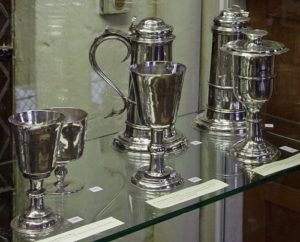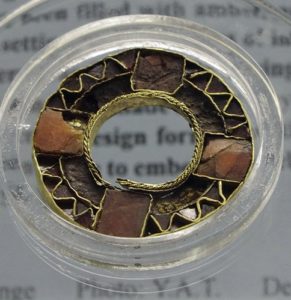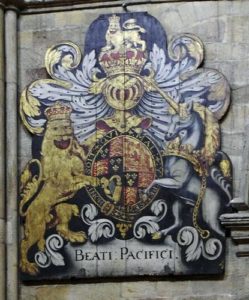Although the building became a cathedral in 1836, it is still better known as Ripon Minster.
The site has been a place of Christian worship from the C7th, when a Benedictine Monastery was founded here. Wilfrid was made abbot here on his return from Rome and built a new Minster church here in 672. Wilfrid was a force to be reckoned with and was instrumental in the decision taken at the Synod of Whitby to adopt the Roman form of Christianity rather than the Celtic. He died in 710 and was buried near the high altar, but his shrine was destroyed during the Reformation.
Wilfrid’s church was destroyed by the Danes in the C10th and only the crypt survived. A new Minster was built but was destroyed by William the Conquer during the Harrying of the North. The present building dates from the C12th. The west end was completed by 1220 and is a good example of the early English Decorated style. The central tower collapsed in 1450 resulting in a lot of damage to the nave, although the transepts escaped. The nave was substantially rebuilt in the Perpendicular style. The clerestory and side aisles were added then.
The cathedral is a splendid building with its twin towered west front with its tall lancet windows providing a striking contrast to the east end with its huge window and buttressed wall turrets. The central tower is quite squat.
Entry is through the west door. Inside it is a glorious building with tall multiple pillars soaring up to pointed arches with a walkway above and the plain glass clerestory windows flooding the nave with light. The crossing arch is still the Norman round arch. Across the base is a medieval stone screen, a pulpitum, with painted figures of Kings of England and bishops set in elaborate pinnacles arches. Above are tiny painted statues of important people in the history of Ripon and the cathedral. The statues may seem old, but according to the information leaflet, they date from 1946.
The beautifully carved medieval floor standing pulpit next to the screen may originally have been placed on top of the screen. Now the organ is above it.
The very elaborate Arts and Crafts movement pulpit dating from 1913 is attached to a pillar in the nave. Standing on green marble legs, the body of the pulpit is covered in bronze. The small figures are the Anglo Saxon saints of Chad, Cuthbert, Hilda and Elthelreda.
In the north transept are the Markenfield tombs. The earliest is in fact the better preserved and shows Sir Thomas in a suit of armour. He died in 1398. The second tomb against the north wall has the effigy of his descendant, another Sir Thomas, who died in 1497. He is lying above a beautifully carved chest with shields round the base.
Wooden doors lead through the stone screen into the quire. This is surrounded on three sides by C15th stalls with carved fronts and ends. The back row have high backs and are set under a fan vaulted canopy decorated with dozens of crocketed pinnacles. The misericords were carved between 1489-94 and depict Bible stories or popular folk lore. There are carvings of humans and animals. The most famous, and the one pointed out to all visitors, is the end misericord on the north side. This has a carving of a griffin catching a rabbit who subsequently escapes down a hole. It is thought to have given Lewis Caroll, whose father was a canon here, his inspiration for the White Rabbit in Alice in Wonderland. There is even a large display in the cathedral promoting this link.
The altar has a beautifully embroidered green and gold cloth. Above is a intricately carved gilded reredos with more figures of kings and bishops set under crocketed ogee arches. This was designed by Sir Ninian Comper and was intended as a war memorial to men from Ripon killed in the First World War.
The chapel on the north side of the chancel has an old font forming the base of the altar. Above is a painted triptych with Christ’s body being taken down from the cross.
The crypt is reached by two sets of stairs; one from the nave, the other from the quire. It is a small cell with barrel ceiling. It is the only part of Wilfrid’s church to survive. At the east end is a small table altar. The small niche in the wall above would originally have contained the relics of saints. Now it contains a C14h alabaster carving of the Resurrection.
Steps lead up to the Treasury in the library above the chapter house. On the wall opposite the stair case is the Royal Coat of Arms.
The Treasury has a display of Communion Plate and church silver dating from the 1570s. There are goblets, tankards, jugs and processional crosses. There is even a silver gilt elephant set with precious jewels. Also on display is the Ripon Jewel, a small Saxon disc broach made of gold and inset with precious stones.
This is a marvellous building and well worth visiting. It is very photogenic and photo permits are £3 from the shop. Entry is free, although it is appreciated if visitors make a donation.
DISABLED ACCESS
Disabled parking is available on the cathedral forecourt by request. The cathedral is fully accessible with the exception of the crypt and the Treasury. Wheelchairs are available for visitors use. Guides and welcomers in their red or blue cloaks are on duty between 10-4.30 and are able to assist or help.
The picture of the lady in a wheelchair wasn't set up specially. I was waiting patiently for a chance to take a photo of the quire with no-one in it, when she appeared. I've included it as proof that the Cathedral is wheelchair friendly.










